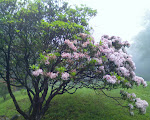Today was the first of many to come where I, and other birders, will spend countless hours looking straight up into the treetops searching for neotropical migrants - especially warblers. At some point during migration, we will develop a mild to serious condition known as “warbler-neck” - the pain resulting from neck strain after looking straight up into treetops with binoculars in hand for long periods of time.
Mark and I spent most of this afternoon visiting with family and feasting on my Dad’s delicious spaghetti dinner (he uses an old family recipe that came over from Italy with my Great-Grandmother Angelina), my Aunt’s savory baked chicken, and all kinds of sinfully delicious desserts. After our visit, I suggested that we needed to burn a few calories so we agreed to take the long way home and try to find a Townsend’s Warbler that was being seen at the Chestnut Hill Park/Reservoir in Brighton – about two thousand miles or so east of its usual migration route!
Upon our arrival, I started searching the treetops for a brightly colored bird no bigger than that of a Snickers Bar. A few minutes later I felt that old familiar twinge that I knew would develop into full-blown warbler-neck if we did not find the bird fast (I was already at a disadvantage having suffered a stiff neck the day before). The strange thing about warbler-neck though is how quickly and momentarily you can forget about it when you actually see a bird. Such was the case for me when I saw my first-of-the-year Palm Warblers, Pine Warblers, Yellow-bellied Sapsucker, and Hermit Thrush - and then - Mark found the Townsend’s Warbler high in the treetops! The late afternoon sun lingering in a clear blue sky created perfect lighting conditions and stunning backdrop for us to watch this bird as it flitted from treetop to treetop in search of food.
For me, this marked the beginning of migration and the amazing May “Daze” that lay ahead. I will endure warbler-neck and at times not even notice its symptoms as I search for and watch these transitory birds feeding and resting before they move on to their breeding grounds. Warbler-neck … what warbler-neck!
To learn more about Townsend’s Warbler go to: http://www.allaboutbirds.org/guide/Townsends_Warbler/id
Sunday, April 19, 2009
Subscribe to:
Comments (Atom)
